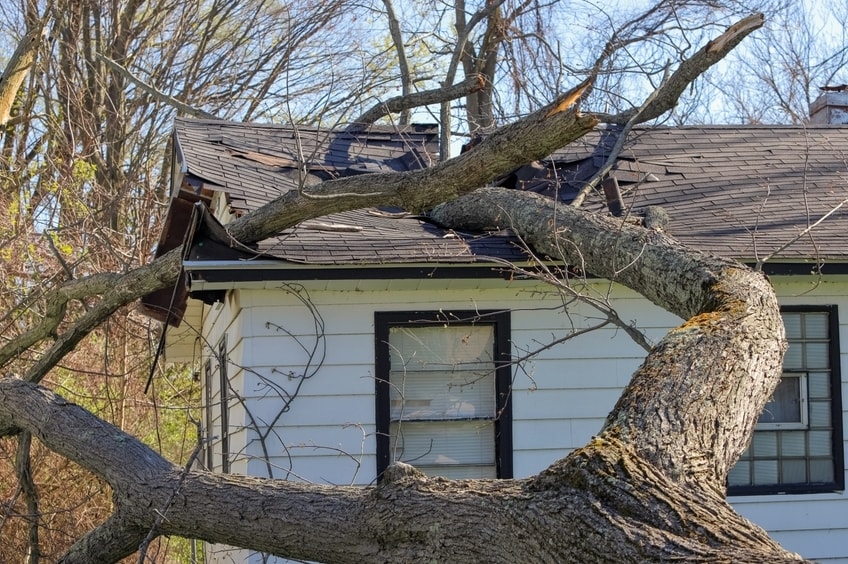If you have trees on your property, you're probably aware of their many benefits. They can boost your property's aesthetic appeal, create privacy, and provide shade to keep your home cooler. Trees can also protect your roof from ultraviolet rays and block wind, minimizing related damage.
However, if trees aren't maintained, they can cause damage to your roof. Here are the signs to look for, what to do if a tree falls on your roof, and how to prevent tree damage to your roof in the future.
How Nearby Trees Can Damage Your Roof
You're likely aware that the worst damage to a roof can occur when an entire tree falls on your home. This can happen during a severe storm or if an older tree is ill or damaged.
However, one tree branch can cause plenty of structural damage, too. Even a small branch falling on or rubbing against your roof can scratch or dent its protective layers, especially if it's laden with snow or ice.
And branches aren't the only culprits that can damage your roof. Fallen leaves, nuts, and needles from trees can accumulate, blocking your gutters and roof valleys. This creates an environment that absorbs moisture, leading to moss or mold growth—both of which can reduce your roof's lifespan. Ponding water from this debris can cause leaks over time.
Overhanging branches can also create too much shade, exacerbating any moisture issues by making it challenging for your roof to dry. Additionally, branches that touch your roof create easy access for squirrels and other animals, potentially leading to intrusions and damaged roofing components.
Signs of Roof Damage
To stop any issues from a tree over the roof from worsening, watch out for signs of roof damage. While a professional inspection can help pinpoint problems by taking a closer look at your roof, you can also perform an inspection from the ground.
Look for any cracked, broken, scratched, or curled shingles. Also, note any missing shingles, especially after a windstorm. Check for moss, mold, or an accumulation of debris like leaves and needles. All of these issues can lead to leaks or larger problems down the road, such as structural damage.
What to Do If a Tree Falls on Your Roof
If a large branch or entire tree has fallen and damaged your roof or siding, prioritize your safety. If you see any live wires, smell gas, or spot major water leaks, call your utility company right away to shut off your service. Evacuate everyone from your home, and call your insurance company. In most cases, the company will send a professional roofer to evaluate the damage.
While you're waiting for the expert to arrive, document the damage by taking photos and video of any areas the fallen tree affected. Once the insurance company has approved your claim, hire a professional to remove the tree and repair the damage.
While most homeowners insurance policies cover roof repairs from tree damage, your insurance company might deny your claim if it discovers you failed to do preventive maintenance.
How to Prevent Tree Damage to Your Roof
Proactively addressing tree-related challenges can help you minimize potential roof damage, saving you time and money in the long run.
Clear Debris
Remove leaves, twigs, needles, and nuts from your roof and gutters. Installing gutter guards can also help prevent debris from clogging them.
Trim Branches
Trim any tree branches that are too close to your roof. Avoid having any part of a tree over the roof—there should be at least 6 feet between your roof and the tips of a tree's branches. If you can't safely trim branches yourself, hire a tree expert.
Remove Dangerous Trees
If an arborist determines that more than one-quarter of a tree's limbs need pruning, you might have to cut down the tree before it can fall on your roof. Don't forget to check with local authorities regarding bylaws and protected tree species.
Plant Trees at a Safe Distance
If you're planting new trees, remember they'll grow large over time. So, select species appropriate for your property's size, and plant them about 20 to 30 feet away from your home.
Prepare for the Next Storm with Expert Help
As the saying goes, the best defense is a good offense. Before another storm can threaten the health of your home's roof, take proactive measures to prevent as much damage as possible.
For more information about preventing tree damage to your roof, check out GAF storm and hurricane roofing resources. To enlist professional help in repairing roof damage or installing a fortified roofing system, reach out to a GAF-certified roofing contractor* in your area.
*Contractors enrolled in GAF certification programs are not employees or agents of GAF, and GAF does not control or otherwise supervise these independent businesses. Contractors may receive benefits, such as loyalty rewards points and discounts on marketing tools from GAF for participating in the program and offering GAF enhanced warranties, which require the use of a minimum amount of GAF products. Your dealings with a Contractor, and any services they provide to you, are subject to the GAF Contractor Terms of Use.

